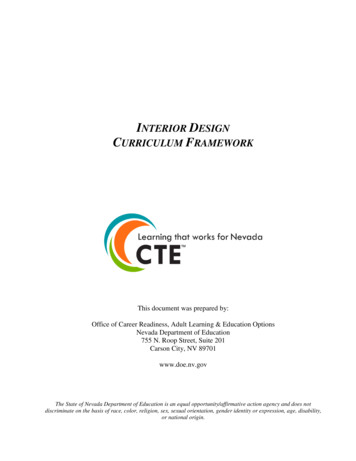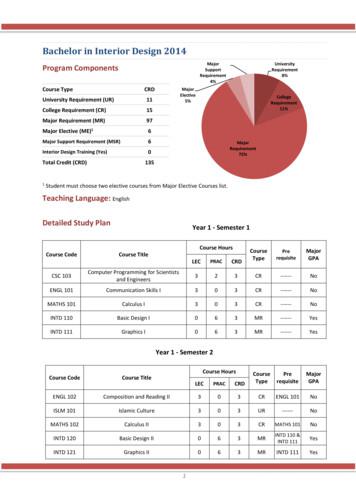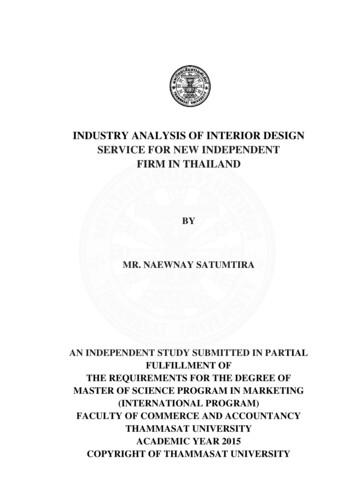Interior Design Curriculum Framework
INTERIOR DESIGNCURRICULUM FRAMEWORKThis document was prepared by:Office of Career Readiness, Adult Learning & Education OptionsNevada Department of Education755 N. Roop Street, Suite 201Carson City, NV 89701www.doe.nv.govThe State of Nevada Department of Education is an equal opportunity/affirmative action agency and does notdiscriminate on the basis of race, color, religion, sex, sexual orientation, gender identity or expression, age, disability,or national origin.
NEVADA CTE CURRICULUM FRAMEWORK2014INTRODUCTIONThe Nevada CTE Curriculum Frameworks are a resource for Nevada’s public and charter schools to design,implement, and assess their CTE programs and curriculum. The content standards identified in this documentare listed as a model for the development of local district programs and curriculum. They represent rigorousand relevant expectations for student performance, knowledge, and skill attainment which have been validatedby industry representatives.The intent of this document is to provide a resource to districts as they develop and implement CTE programsand curricula.This program ensures the following thresholds are met: The CTE course and course sequence teaches the knowledge and skills required by industrythrough applied learning methodology and, where appropriate, work-based learningexperiences that prepare students for careers in high-wage, high-skill and/or high-demandfields. Regional and state economic development priorities shall play an important role indetermining program approval. Some courses also provide instruction focused on personaldevelopment.The CTE course and course sequence includes leadership and employability skills as anintegral part of the curriculum.The CTE course and course sequence are part of a rigorous program of study and includesufficient technical challenge to meet state and/or industry-standards.The CTE program components include the following items: Program of StudyState Skill StandardsEmployability Skills for Career Readiness StandardsCareer Technical Student Organizations (CTSO)Curriculum FrameworkCTE Assessments: Workplace Readiness Skills Assessment End-of-Program Technical AssessmentCertificate of Skill AttainmentCTE Endorsement on a High School Diploma CTE College CreditReleased: 11/06/2014Interior Design1
NEVADA CTE CURRICULUM FRAMEWORK2014NEVADA DEPARTMENT OF EDUCATIONCURRICULUM FRAMEWORK FORINTERIOR DESIGNPROGRAM TITLE: INTERIOR DESIGNSTATE SKILL STANDARDS: INTERIOR DESIGNSTANDARDS REFERENCE CODE: IDCAREER CLUSTER : INFORMATION & MEDIA TECHNOLOGIESCAREER PATHWAY: ARTS, A/V TECHNOLOGY & COMMUNICATIONPROGRAM LENGTH: 3 LEVELS (L1, L2, L3C)PROGRAM ASSESSMENTS: INTERIOR DESIGNWORKPLACE READINESS SKILLSCTSO: FCCLAGRADE LEVEL: 9-12AVAILABLE INDUSTRY PRE-PAC HOUSING AND FURNISHINGSCERTIFICATIONS/LICENSES PRE-PAC INTERIOR DESIGN AND HOME FURNISHINGSPROVIDERS:PROGRAM PURPOSEThe purpose of this program is to prepare students for postsecondary education and employment in theInterior Design industry.The program includes the following state standards: Nevada CTE Skill Standards: Interior DesignEmployability Skills for Career ReadinessNevada Academic Content Standards (alignment shown in the Nevada CTE Skill Standards): Science (based on the Next Generation Science Standards) English Language Arts (based on the Common Core State Standards) Mathematics (based on the Common Core State Standards)Common Career Technical Core (alignment shown in the Nevada CTE Skill Standards)CAREER CLUSTERSThe National Career Clusters Framework provides a vital structure for organizing and delivering qualityCTE programs through learning and comprehensive programs of study (POS). In total, there are 16 CareerClusters in the National Career Clusters Framework, representing more than 79 Career Pathways to helpstudents navigate their way to greater success in college and career. As an organizing tool for curriculumdesign and instruction, Career Clusters provide the essential knowledge and skills for the 16 CareerClusters and their Career Pathways.**Cite: National Association of State Directors of Career Technical Education Consortium. (2012). Retrievedfrom areerclusters.htmlReleased: 11/06/2014Interior Design2
NEVADA CTE CURRICULUM FRAMEWORK2014PROGRAM OF STUDYThe program of study illustrates the sequence of academic and career and technical education coursework thatis necessary for the student to successfully transition into postsecondary educational opportunities andemployment in their chosen career path. (NAC 389.803)PROGRAM STRUCTUREThe core course sequencing provided in the following table serves as a guide to schools for their programs ofstudy. Each course is listed in the order in which it should be taught and has a designated level. Completeprogram sequences are essential for the successful delivery of all state standards in each program area.INTERIOR DESIGNCore Course Sequence with Complementary CoursesCOURSE NAMELEVELInterior Design IFoundations of Design*Interior Design IIInterior Design II LAB*Interior Design IIIInterior Design III LAB*Interior Design Advanced Studies**Complementary CoursesL1L1L2L2LL3CL3LASSTATE SKILL STANDARDSThe state skill standards are designed to clearly state what the student should know and be able to do uponcompletion of an advanced high school career and technical education (CTE) program. The standards aredesigned for the student to complete all standards through their completion of a program of study. Thestandards are designed to prepare the student for the end-of-program technical assessment directly aligned tothe standards. (Paragraph (a) of Subsection 1 of NAC 389.800)EMPLOYABILITY SKILLS FOR CAREER READINESS STANDARDSEmployability skills, often referred to as “soft skills”, have for many years been a recognizable component ofthe standards and curriculum in career and technical education programs. The twenty-one standards areorganized into three areas: (1) Personal Qualities and People Skills; (2) Professional Knowledge and Skills;and (3) Technology Knowledge and Skills. The standards are designed to ensure students graduate highschool properly prepared with skills employers prioritize as the most important. Instruction on all twenty-onestandards must be part of each course of the CTE program. (Paragraph (d) of Subsection 1 of NAC 389.800)CURRICULUM FRAMEWORKThe Nevada CTE Curriculum Frameworks are organized utilizing the recommended course sequencing listedin the Program of Study and the CTE Course Catalog. The framework identifies the recommended contentstandards, performance standards, and performance indicators that should be taught in each course.CAREER AND TECHNICAL STUDENT ORGANIZATIONS (CTSOS)To further the development of leadership and technical skills, students must have opportunities to participatein one or more of the Career and Technical Student Organizations (CTSOs). CTSOs develop character,citizenship, and the technical, leadership and teamwork skills essential for the workforce and their furthereducation. Their activities are considered a part of the instructional day when they are directly related to thecompetencies and objectives in the course. (Paragraph (a) of Subsection 3 of NAC 389.800)Released: 11/06/2014Interior Design3
NEVADA CTE CURRICULUM FRAMEWORK2014WORKPLACE READINESS SKILLS ASSESSMENTThe Workplace Readiness Skills Assessment has been developed to align with the Nevada CTEEmployability Skills for Career Readiness Standards. This assessment provides a measurement of studentemployability skills attainment. Students who complete a program will be assessed on their skill attainmentduring the completion level course. Completion level courses are identified by the letter “C”.(e.g., Level L3C) (Paragraph (d) of Subsection 1 of NAC 389.800)END-OF-PROGRAM TECHNICAL ASSESSMENTAn end-of-program technical assessment has been developed to align with the Nevada CTE Skill Standardsfor this program. This assessment provides a measurement of student technical skill attainment. Studentswho complete a program will be assessed on their skill attainment during the completion level course.Completion level courses are identified by the letter “C”. (e.g., Level L3C)(Paragraph (e) of Subsection 1 of NAC 389.800)CERTIFICATE OF SKILL ATTAINMENTEach student who completes a course of study must be awarded a certificate which states that they haveattained specific skills in the industry being studied and meets the following criteria: A student must maintaina 3.0 grade point average in their approved course of study, pass the Workplace Readiness Skills Assessment,and pass the end-of-program technical assessment. (Subsection 4 of NAC 389.800)CTE ENDORSEMENT ON A HIGH SCHOOL DIPLOMAA student qualifies for a CTE endorsement on their high school diploma after successfully completing thefollowing criteria: 1) successful completion of a CTE course of study in a program area, 2) successfulcompletion of academic requirements governing receipt of a standard diploma, and 3) meet all requirementsfor the issuance of the Certificate of Skill Attainment. (NAC 389.815)CTE COLLEGE CREDITCTE College Credit is awarded to students based on articulation agreements established by each college forthe CTE program, where the colleges will determine the credit value of a full high school CTE program basedon course alignment. An articulation agreement will be established for each CTE program designating thenumber of articulated credits each college will award to students who complete the program.CTE College Credit is awarded to students who: (1) complete the CTE course sequence with a grade-pointaverage of 3.0 or higher; (2) pass the state end-of-program technical assessment for the program; and (3) passthe Workplace Readiness Assessment for employability skills.Pre-existing articulation agreements will be recognized until new agreements are established according tocurrent state policy and the criteria shown above.Please refer to the local high school’s course catalog or contact the local high school counselor for moreinformation. (Paragraph (b) of Subsection 3 of NAC 389.800)ACADEMIC CREDIT FOR CTE COURSEWORKCareer and technical education courses meet the credit requirements for high school graduation (1 unit of artsand humanities or career and technical education). Some career and technical education courses meetacademic credit for high school graduation. Please refer to the local high school’s course catalog or contactthe local high school counselor for more information. (NAC 389.672)Released: 11/06/2014Interior Design4
NEVADA CTE CURRICULUM FRAMEWORK2014CORE COURSE:RECOMMENDED STUDENT PERFORMANCE STANDARDSCOURSE TITLE: Interior Design IABBR. NAME: INT DESIGN ICREDITS:1LEVEL: L1CIP CODE: 50.0408PREREQUISITE: NoneCTSO: FCCLACOURSE DESCRIPTIONThis course provides students with an introduction to residential design. Students learn about the elements andprincipals of design and how to apply them in the planning of interior spaces. Areas of study include understandingboth personal and clients wants and needs, housing options, design styles, architectural styles, introduction toarchitectural drawings, and career opportunities in the field of interior design.TECHNICAL STANDARDSCONTENT STANDARD 1.0 : EXPLORE CAREERS AND PROFESSIONAL PRACTICES IN INTERIORDESIGNPerformance Standard 1.2 : Analyze Career Paths and OpportunitiesPerformance Indicators : 1.2.3Performance Standard 1.4 : Demonstrate Awareness of Registration Requirements for Professional OrganizationsPerformance Indicators : 1.4.3-1.4.4CONTENT STANDARD 2.0 : EXPLORE DESIGN FUNDAMENTALSPerformance Standard 2.1 : Utilize Elements of DesignPerformance Indicators : 2.1.1-2.1.8Performance Standard 2.2 : Analyze Color and its Effects in DesignPerformance Indicators : 2.2.1-2.2.3, 2.2.6-2.2.8Performance Standard 2.3 : Investigate Textiles for EnvironmentsPerformance Indicators : 2.3.1-2.3.2Performance Standard 2.4 : Utilize the Principles of DesignPerformance Indicators : 2.4.1-2.4.7Performance Standard 2.5 : Compare and Contrast DesignPerformance Indicators : 2.5.1-2.5.2, 2.5.6Performance Standard 2.6 : Demonstrate Professional Presentation TechniquesPerformance Indicators : 2.6.1-2.6.2, 2.6.4CONTENT STANDARD 3.0 : EXPLORE INFLUENCES THAT AFFECT HOUSING CHOICESPerformance Standard 3.1 : Evaluate the Influence of Needs and Wants on Housing ChoicesPerformance Indicators : 3.1.1-3.1.2Performance Standard 3.3 : Analyze the Impact of Other Factors on Housing ChoicesPerformance Indicators : 3.3.1CONTENT STANDARD 4.0 : EVALUATE RESIDENTIAL DESIGNPerformance Standard 4.1 : Investigate Alternatives in Residential DesignPerformance Indicators : 4.1.1-4.1.4 . continue on next pageReleased: 11/06/2014Interior Design5
NEVADA CTE CURRICULUM FRAMEWORKCONTENT STANDARD 5.0 :Performance Standard 5.1 :Performance Indicators :CONTENT STANDARD 7.0 :Performance Standard 7.1 :Performance Indicators :Performance Standard 7.2 :Performance Indicators :Performance Standard 7.3 :Performance Indicators :CONTENT STANDARD 9.0 :Performance Standard 9.1 :Performance Indicators :Performance Standard 9.2 :Performance Indicators :2014INVESTIGATE CONSTRUCTIONAnalyze Various Methods of Construction5.1.2DEVELOP SPACE PLANNING SKILLSDemonstrate Space Planning7.1.1-7.1.2Demonstrate Floor Plan Development and Skills7.2.6-7.2.7Explore Space Planning Considerations for Specific Areas7.3.1-7.3.2, 7.3.6EVALUATE COMMERCIAL DESIGNExamine General Considerations of Commercial Design9.1.1Explore the Various Types of Commerical Design Specialties9.2.1EMPLOYABILITY SKILLS FOR CAREER READINESS STANDARDSCONTENT STANDARD 1.0 :Performance Standard 1.1 :Performance Indicators :Performance Standard 1.2 :Performance Indicators :Performance Standard 1.3 :Performance Indicators :DEMONSTRATE EMPLOYABILITY SKILLS FOR CAREER READINESSDemonstrate Personal Qualities and People Skills1.1.1-1.1.7Demonstrate Professional Kno
Interior Design I L1 Foundations of Design* L1 Interior Design II L2 Interior Design II LAB* L2L Interior Design III L3C Interior Design III LAB* L3L Interior Design Advanced Studies * AS *Complementary Courses S TATE S KILL S TANDARDS The state skill standards are designed to clearly state what the student should know and be able to do upon
Early Childhood (K-3) Syllabus 1-4 The following diagram illustrates the connections among the Curriculum Framework, the progress maps, the Curriculum Framework Curriculum Guides and the K-10 syllabuses. Connections among the Curriculum Framework, the Curriculum Framework Progress Maps/Outcomes and Standards Framework, the Curriculum Framework Curriculum Guides and the Early Childhood (K-3 .
What is Interior Design? Interior Design is a "unique blend of art and science. Interior decorating is the embellishment of interior finishes and the selection and arrangement of fabrics and furnishings" according to Beginnings of Interior Environment by Phyllis Sloan Allen, Lynn M. Jones and Miriam F. Stimpson. Interior designers are trained .
3.0 TYPES OF CURRICULUM There are many types of curriculum design, but here we will discuss only the few. Types or patterns are being followed in educational institutions. 1. Subject Centred curriculum 2. Teacher centred curriculum 3. Learner centred curriculum 4. Activity/Experience curriculum 5. Integrated curriculum 6. Core curriculum 7.
interior spaces, interior surfaces, furniture, and ornamentation. Course Code: INTD 216 Course Title: Color in Interior Use of color in interiors. Emphasis on color theory, psychology of color and its effects on moods. Application of color in interior environments with lighting conditions. Course Code: INTD 220 Course Title: Interior Design II
Figure 6: 3 sub-segments of interior design firm’s client. 17 Figure 7: Customer segment of interior design market 19 Figure 8: Logo of TIDA (Thailand Interior Designer association) 20 Figure 9: Design process 21 Figure 10: Schematic design 22 Figure 11: Interior turnkey scope of
Aug 27, 2006 · The Interior Design Manual (IDM) will provide VA staff participating in the development of interior design projects with an understanding of their roles, responsibilities and the appropriate procedures for creating a comprehensive Interior Design environment. All VA staff members taking part in interior design are expected to follow this manual
is a need for interior design textbooks to reflect this context and allow interior design students to keep pace with rapid development of the industry. This series of interior design textbooks is aimed at satisfying the needs of Hong Kong interior design students at different academic levels from diploma, higher diploma to bachelor's degree .
study of p-rough paths and their collection is done in the second part of the course. Guided by the results on flows of the first part, we shall reinterpret equation (0.4) to construct directly a flow ϕsolution to the equation (0.6) dϕ F X(dt), in a sense to be made precise in the third part of the course. The recipe of construction of ϕwill consist in associating to F and X a C1 .























